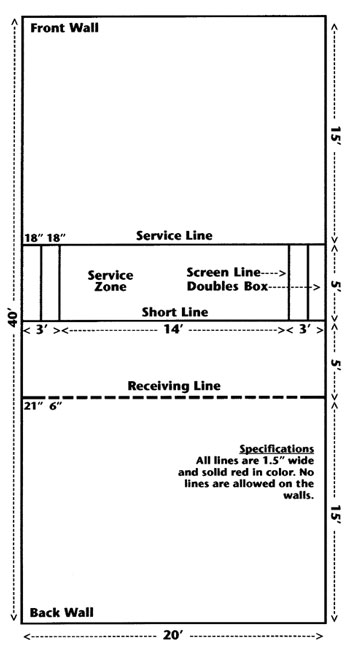Basic Racquetball Rules

Play starts with the server standing in the service zone (the area between two solid parallel lines in the middle of the court – see the diagram on the left), bouncing the ball once on the floor, and hitting it towards the wall on the opposite side of the opponent. Once the ball bounces off the front wall and flies beyond the service zone, the rally is on. The players alternate taking shots at the front wall until someone is unable to keep the ball from bouncing on the floor more than once when receiving or reaching the front wall when returning a shot, thus losing the rally.
The player who wins the rally always gets to serve. Points can only be scored by the serving player and winning a rally during a serve scores exactly one point. When the serving player loses the rally, no points are gained or lost, but the other player gets to serve and now has a chance of scoring. A single match is made up of three games, where the first two games go until 15 points and the last game only goes until 11.
A good serve happens when the ball hits the front wall before anything else, flies over the service zone, and does not hit the back wall before hitting the floor (it’s OK to hit one side wall). If at least one of these things do not occur, it is considered to be a fault serve. The server gets two chances to make a good serve. If both serves result in a fault serve, the other player now gets to serve.
Due to the nature of the game both players can potentially occupy the same area of the court, thus blocking one of the players from making the best shot they can, or seeing the ball, or striking the other player with the ball. This is called a hinder and it typically results in a simple replay of the rally.
These are the basic racquetball rules you need to be aware of to get a functional game going. I consciously glossed over many details to keep this short so you can get out there and start having fun with this wonderful game. Just be safe and watch out for hitting your opponent with either the racket or the ball. But if you are interested in all the nitty-gritty details of the rules, you can find most of them explained in the Advanced Racquetball Rules page of this site.
To demonstrate the game in action here’s a short video of several rallies between Paola Longoria (white tanktop) and Samantha Salas Solis (purple/gray tanktop) during 2011 US Open, followed by a quick analysis of what is happening.
Paola serves first, using a Z-serve so the ball hits the front wall, then the side wall, and lands on the floor after the service line. Samantha returns the serve so that the ball hits the front wall and then bounces on the floor twice before Paola can get to it. This causes Paola to lose the rally – a sideout – and no points are awarded.
Next, Samantha serves and the players alternate hitting the ball into the front wall until finally Paola hits it so it bounces on the floor twice before Samantha can get to it. Once again, it’s a sideout and no points are awarded.
Next up is Paola serving again. This time Samantha skips the ball on her return, which means it hits the floor before it hits the front wall. This causes her to lose the rally and Paola is awarded one point. Paola gets to keep serving and after a few exchanges, she wins this rally again by hitting the ball in such a way that Samantha is not able to reach it before it bounces twice on the floor. Another point for Paola and she gets to serve again.
For the next rally, Samantha hits a splat shot where the ball hits a side wall, then the front wall, and then bounces a couple of times on the floor before Paola can get to it. Like before, this is a sideout, no point is awarded, and Samantha is back to serving. The next two rallies also result in sideouts and no points are awarded.
